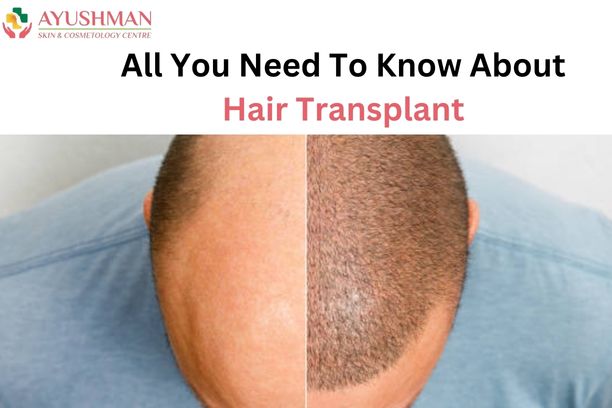A hair transplant is a procedure where hair is moved from one part of your head to another. This is typically done through grafting, which is the most common method. To be eligible for a hair transplant, you should have areas of thicker hair on your head. Hair loss can be permanent and caused by various factors, such as certain types of alopecia.
Table of Contents
ToggleWhat is a hair transplant?
A hair transplant is a surgery that moves hair to areas of the scalp where hair is thinning or bald. It’s also known as hair restoration or hair replacement. This procedure is typically for people who have already tried other treatments for hair loss. Dermatologists (doctors who specialize in skin health) or plastic surgeons (doctors who specialize in reconstructive surgeries) are the ones who perform hair transplants.
How does a hair transplant work?
During a hair transplant, the doctor takes small sections of skin, called grafts, from areas of the body with healthy hair. This area is called the donor site and is usually at the back of your scalp where hair is thickest. The doctor then moves these grafts to areas of the scalp where hair is missing. After the transplanted skin heals, it should start growing hair in those previously bald areas.
What conditions does hair restoration surgery treat?
Hair loss can happen for various reasons, and while some cases are temporary, others are permanent. Hair restoration surgery, such as hair implants, can help with permanent hair loss caused by:
- Alopecia areata: This is an autoimmune disease that targets hair follicles.
- Androgenic alopecia: Also known as pattern baldness, it’s a common cause of hair loss.
- Thyroid diseases or hormonal imbalances: Conditions affecting the thyroid or hormones can lead to hair loss.
- Traumatic injuries or burns: Injuries or burns to the scalp can result in permanent hair loss.
Who is eligible for hair replacement?
You might be a good candidate for hair replacement surgery if you:
- Are healthy overall.
- Have realistic expectations about the results of hair replacement.
- Still have some areas on your scalp with thick hair growth.
What are the different types of hair transplant surgery?
Hair transplant surgery can be done in several ways:
Grafting: This is the most common method. The surgeon takes small pieces of scalp with healthy hair and places them in bald areas. These pieces, often called “hair plugs” or micrografts, contain one to two hairs each. The procedure can take several hours, and you may need multiple sessions for full coverage.
Scalp reduction: Also known as alopecia reduction, this procedure involves removing a small bald area from the scalp and pulling nearby hair-containing skin over it, then stitching it in place. It’s best for bald spots on the top or back of the head and usually requires only local anesthesia.
Flap surgery: This is recommended for large bald areas near the front of the scalp. It’s done in multiple stages over several weeks. The surgeon cuts around three sides of the donor site and lifts a flap of skin with its blood supply intact to cover the bald area. Flap surgery requires general anesthesia.
Tissue expansion: If you have scalp baldness or disfigurement from burns, tissue expansion might be an option. It involves inserting a balloon-like device called a tissue expander under the scalp where hair still grows. Over time, the expander is gradually filled to stretch the skin. In a second procedure, the stretched skin is used to cover the bald area. This surgery requires general anesthesia.
What are the risks of hair transplant surgery?
Like any surgery, hair transplant procedures carry certain risks, such as:
- Allergic reactions to anesthesia.
- Excessive bleeding.
- Failed grafts or flaps.
- Infections.
- Loss of sensation in the scalp.
- Scarring.
What are the side effects of hair transplant surgery?
Side effects of hair transplant surgery are usually temporary and may include:
- Crusting or scabbing on the scalp.
- Itching.
- Temporary loss of sensation.
- Pain or throbbing.
- Swelling.
- Tightness in the scalp.
What are the benefits of hair restoration?
Hair restoration surgery offers several potential benefits, including:
- A fuller head of hair with fewer bald areas.
- Improved self-esteem.
- A permanent solution for hair loss.
What is the recovery process after hair transplant surgery?
After a hair transplant surgery, most people can go home the same day since it’s usually an outpatient procedure. Your recovery time will vary depending on the type of transplant you had. Here’s a general timeline:
Day 1: You can remove the bandages.
Day 2: You can wash your hair.
Days 3 to 5: You can return to work and start light activities.
After 10 days: Your healthcare provider will remove any stitches.
After 3 weeks: You can gradually return to exercise or sports.
How long do the results last?
It may take up to a year to see the full results of your hair transplant. Don’t worry if some of the transplanted hair falls out during the healing process; this is normal, and the hair should grow back. Sometimes, additional touch-up surgeries may be needed to achieve a natural look.
When should you see your doctor?
You’ll likely have follow-up appointments with your healthcare provider to ensure your scalp is healing properly. However, contact your provider immediately if you experience:
- A persistent fever.
- Excessive bleeding from your scalp.
- Severe redness or pain on your scalp.
- Signs of infection, such as pus oozing from the scalp cuts, especially if it’s green or yellow.
Conclusion
If other treatments for hair growth haven’t been successful, hair transplant surgery could be an option for you. There are various techniques for hair transplants, so it’s essential to collaborate with a healthcare provider to select the method that aligns with your goals. Make sure to choose a skilled professional with expertise in hair loss and restoration to perform the surgery. Additionally, consider practical factors like the cost and recovery time between treatments when deciding on hair transplant surgery.




